Optical Frequency Comb Generator Employing Two Cascaded Frequency Modulators and Mach–Zehnder Modulator
Abstract
:1. Introduction
2. Principle of Operation
3. Results and Discussion
4. Conclusions
Author Contributions
Funding
Data Availability Statement
Conflicts of Interest
References
- Udem, T.; Holzwarth, R.; Hänsch, T.W. Optical frequency metrology. Nature 2002, 416, 233–237. [Google Scholar] [CrossRef]
- Fortier, T.; Baumann, E. 20 Years of developments in optical frequency comb technology and applications. Commun. Phys. 2019, 2, 153. [Google Scholar] [CrossRef] [Green Version]
- Capmany, J.; Novak, D. Microwave photonics combines two worlds. Nat. Photonics 2007, 1, 319. [Google Scholar] [CrossRef]
- Chen, C.; Zhang, C.; Zhang, W.; Jin, W.; Qiu, K. Scalable and reconfigurable generation of flat optical comb for WDM-based next-generation broadband optical access networks. Opt. Commun. 2014, 321, 16–22. [Google Scholar] [CrossRef]
- Schibli, T.; Minoshima, K.; Hong, F.L.; Inaba, H.; Onae, A.; Matsumoto, H.; Hartl, I.; Fermann, M. Frequency metrology with a turnkey all-fiber system. In Proceedings of the Ultrafast Phenomena XIV: Proceedings of the 14th International Conference, Niigata, Japan, 25–30 July 2004; Springer: Berlin/Heidelberg, Germany, 2005; pp. 843–845. [Google Scholar]
- Cingöz, A.; Yost, D.C.; Allison, T.K.; Ruehl, A.; Fermann, M.E.; Hartl, I.; Ye, J. Direct frequency comb spectroscopy in the extreme ultraviolet. Nature 2012, 482, 68–71. [Google Scholar] [CrossRef] [Green Version]
- Jia, S.; Yu, X.; Hu, H.; Yu, J.; Guan, P.; Da Ros, F.; Galili, M.; Morioka, T.; Oxenløwe, L.K. THz photonic wireless links with 16-QAM modulation in the 375–450 GHz band. Opt. Express 2016, 24, 23777–23783. [Google Scholar] [CrossRef] [Green Version]
- Zhang, H.; Chang, B.; Li, Z.; Liang, Y.; Qin, C.; Wang, C.; Xia, H.; Tan, T.; Yao, B. Optical frequency combs: From principles to applications. J. Electron. Sci. Technol. 2022, 20, 120–148. [Google Scholar] [CrossRef]
- Davila-Rodriguez, J.; Bagnell, K.; Delfyett, P.J. Frequency stability of a 10 GHz optical frequency comb from a semiconductor-based mode-locked laser with an intracavity 10,000 finesse etalon. Opt. Lett. 2013, 38, 3665–3668. [Google Scholar] [CrossRef] [PubMed]
- Kippenberg, T.J.; Gaeta, A.L.; Lipson, M.; Gorodetsky, M.L. Dissipative Kerr solitons in optical microresonators. Science 2018, 361, eaan8083. [Google Scholar] [CrossRef] [Green Version]
- Qu, K.; Zhao, S.; Li, X.; Zhu, Z.; Liang, D.; Liang, D. Ultra-flat and broadband optical frequency comb generator via a single Mach–Zehnder modulator. IEEE Photonics Technol. Lett. 2016, 29, 255–258. [Google Scholar] [CrossRef]
- Morohashi, I.; Sakamoto, T.; Sotobayashi, H.; Kawanishi, T.; Hosako, I. Broadband optical comb generation using mach-zehnder-modulator-based flat comb generator with feedback loop. In Proceedings of the 36th European Conference and Exhibition on Optical Communication, Turin, Italy, 19–23 September 2010; pp. 1–3. [Google Scholar]
- Wang, D.; Zhang, M.; Li, Z.; Li, J.; Fu, M.; Cui, Y.; Chen, X. Modulation format recognition and OSNR estimation using CNN-based deep learning. IEEE Photonics Technol. Lett. 2017, 29, 1667–1670. [Google Scholar] [CrossRef]
- Sharma, V.; Singh, S. Cross-phase modulation based ultra-flat 90-line optical frequency comb generation. Opt. Quantum Electron. 2021, 53, 657. [Google Scholar] [CrossRef]
- Sakamoto, T.; Kawanishi, T.; Izutsu, M. Widely wavelength-tunable ultra-flat frequency comb generation using conventional dual-drive Mach-Zehnder modulator. Electron. Lett. 2007, 43, 1039–1040. [Google Scholar] [CrossRef]
- Ozharar, S.; Quinlan, F.; Ozdur, I.; Gee, S.; Delfyett, P. Ultraflat optical comb generation by phase-only modulation of continuous-wave light. IEEE Photonics Technol. Lett. 2007, 20, 36–38. [Google Scholar] [CrossRef]
- Mishra, A.K.; Schmogrow, R.; Tomkos, I.; Hillerkuss, D.; Koos, C.; Freude, W.; Leuthold, J. Flexible RF-based comb generator. IEEE Photonics Technol. Lett. 2013, 25, 701–704. [Google Scholar] [CrossRef]
- Yamamoto, T.; Komukai, T.; Suzuki, K.; Takada, A. Multicarrier light source with flattened spectrum using phase modulators and dispersion medium. J. Light. Technol. 2009, 27, 4297–4305. [Google Scholar] [CrossRef]
- Wu, R.; Supradeepa, V.; Long, C.M.; Leaird, D.E.; Weiner, A.M. Generation of very flat optical frequency combs from continuous-wave lasers using cascaded intensity and phase modulators driven by tailored radio frequency waveforms. Opt. Lett. 2010, 35, 3234–3236. [Google Scholar] [CrossRef] [PubMed] [Green Version]
- Dou, Y.; Zhang, H.; Yao, M. Improvement of flatness of optical frequency comb based on nonlinear effect of intensity modulator. Opt. Lett. 2011, 36, 2749–2751. [Google Scholar] [CrossRef]
- Dou, Y.; Zhang, H.; Yao, M. Generation of flat optical-frequency comb using cascaded intensity and phase modulators. IEEE Photonics Technol. Lett. 2012, 24, 727–729. [Google Scholar] [CrossRef]
- Wang, Q.; Huo, L.; Xing, Y.; Zhou, B. Ultra-flat optical frequency comb generator using a single-driven dual-parallel Mach–Zehnder modulator. Opt. Lett. 2014, 39, 3050–3053. [Google Scholar] [CrossRef]
- Zhang, F.; Wu, J.; Li, Y.; Lin, J. Flat optical frequency comb generation and its application for optical waveform generation. Opt. Commun. 2013, 290, 37–42. [Google Scholar] [CrossRef]
- Hmood, J.K.; Emami, S.D.; Noordin, K.A.; Ahmad, H.; Harun, S.W.; Shalaby, H.M. Optical frequency comb generation based on chirping of Mach–Zehnder modulators. Opt. Commun. 2015, 344, 139–146. [Google Scholar] [CrossRef]
- Yan, X.; Zou, X.; Pan, W.; Yan, L.; Azaña, J. Fully digital programmable optical frequency comb generation and application. Opt. Lett. 2018, 43, 283–286. [Google Scholar] [CrossRef]
- Wang, Z.; Ma, M.; Sun, H.; Khalil, M.; Adams, R.; Yim, K.; Jin, X.; Chen, L.R. Optical frequency comb generation using CMOS compatible cascaded Mach–Zehnder modulators. IEEE J. Quantum Electron. 2019, 55, 1–6. [Google Scholar] [CrossRef]
- Ullah, S.; Ullah, R.; Zhang, Q.; Khalid, H.A.; Memon, K.A.; Khan, A.; Tian, F.; Xiangjun, X. Ultra-wide and flattened optical frequency comb generation based on cascaded phase modulator and LiNbO3-MZM offering terahertz bandwidth. IEEE Access 2020, 8, 76692–76699. [Google Scholar] [CrossRef]
- Cui, Y.; Wang, Z.; Zuo, X.; Xu, Y.; Jiang, Y.; Yu, J.; Huang, Z. Flat optical frequency comb generation by using one DPMZM and superposed harmonics. Opt. Commun. 2023, 531, 129223. [Google Scholar] [CrossRef]
- Muhanad Fadhel, M.; Rashid, H.; Essa Hamzah, A.; Dzulkefly Zan, M.S.; Abd Aziz, N.; Arsad, N. Flat frequency comb generation employing cascaded single-drive Mach–Zehnder modulators with a simple analogue driving signal. J. Mod. Opt. 2021, 68, 536–541. [Google Scholar] [CrossRef]
- Fan, Y.; Li, P. Optical frequency comb based on cascaded MZM-EAM with Gaussian-shaped pulse signal. Opt. Eng. 2021, 60, 056106. [Google Scholar] [CrossRef]
- Sharma, V.; Singh, S. Design of tunable optical frequency comb generation based on electro-optic modulator. Photonic Netw. Commun. 2022, 44, 133–140. [Google Scholar] [CrossRef]
- Demirtzioglou, I.; Lacava, C.; Bottrill, K.R.; Thomson, D.J.; Reed, G.T.; Richardson, D.J.; Petropoulos, P. Frequency comb generation in a silicon ring resonator modulator. Opt. Express 2018, 26, 790–796. [Google Scholar] [CrossRef] [PubMed]
- Zhang, M.; Wang, C.; Buscaino, B.; Shams-Ansari, A.; Kahn, J.M.; Loncar, M. Electro-optic frequency comb generation in ultrahigh-Q integrated lithium niobate micro-resonators. In Proceedings of the CLEO: QELS_Fundamental Science, San Jose, CA, USA, 13–18 May 2018; Optica Publishing Group: Washington, DC, USA, 2018; p. FW3E-4. [Google Scholar]
- Kulagin, V.; Valuev, V.; Kontorov, S.; Kornienko, V.; Prokhorov, D.; Cherepenin, V. Optical frequency comb in optoelectronic oscillator with delay line and microresonator. In Proceedings of the 2022 International Conference Laser Optics (ICLO), Saint Petersburg, Russia, 20–24 June 2022; p. 1-1. [Google Scholar]
- Wu, X.; Tsang, H. Flat-top frequency comb generation with silicon microring modulator and filter. In Proceedings of the 2017 Conference on Lasers and Electro-Optics (CLEO), San Jose, CA, USA, 14–19 May 2017; pp. 1–2. [Google Scholar]
- Liu, Y.; Wu, S.; Shen, X. Ultra-Flat Optical Frequency Comb Generation Based on Electro-Optic Intensity Modulator with Digital Driving Signal. 2022. Available online: https://www.researchsquare.com/article/rs-1137183/v1 (accessed on 11 May 2022).
- Cui, Y.; Wang, Z.; Xu, Y.; Jiang, Y.; Yu, J.; Huang, Z. Generation of flat optical frequency comb using cascaded PMs with combined harmonics. IEEE Photonics Technol. Lett. 2022, 34, 490–493. [Google Scholar] [CrossRef]
- Shen, J.; Wu, S.; Li, D. Ultra-flat optical frequency comb generation based on phase modulation with simple digital driving signal. Optik 2019, 198, 163254. [Google Scholar] [CrossRef]
- Li, Y.; Chen, Y.W.; Zhou, W.; Tang, X.; Shi, J.; Zhao, L.; Yu, J.; Chang, G.K. D-band mm-wave SSB vector signal generation based on cascaded intensity modulators. IEEE Photonics J. 2020, 12, 1–11. [Google Scholar] [CrossRef]
- Lin, C.T.; Lin, Y.M.; Chen, J.J.; Dai, S.P.; Shih, P.T.; Peng, P.C.; Chi, S. Optical direct-detection OFDM signal generation for radio-over-fiber link using frequency doubling scheme with carrier suppression. Opt. Express 2008, 16, 6056–6063. [Google Scholar] [CrossRef] [PubMed]
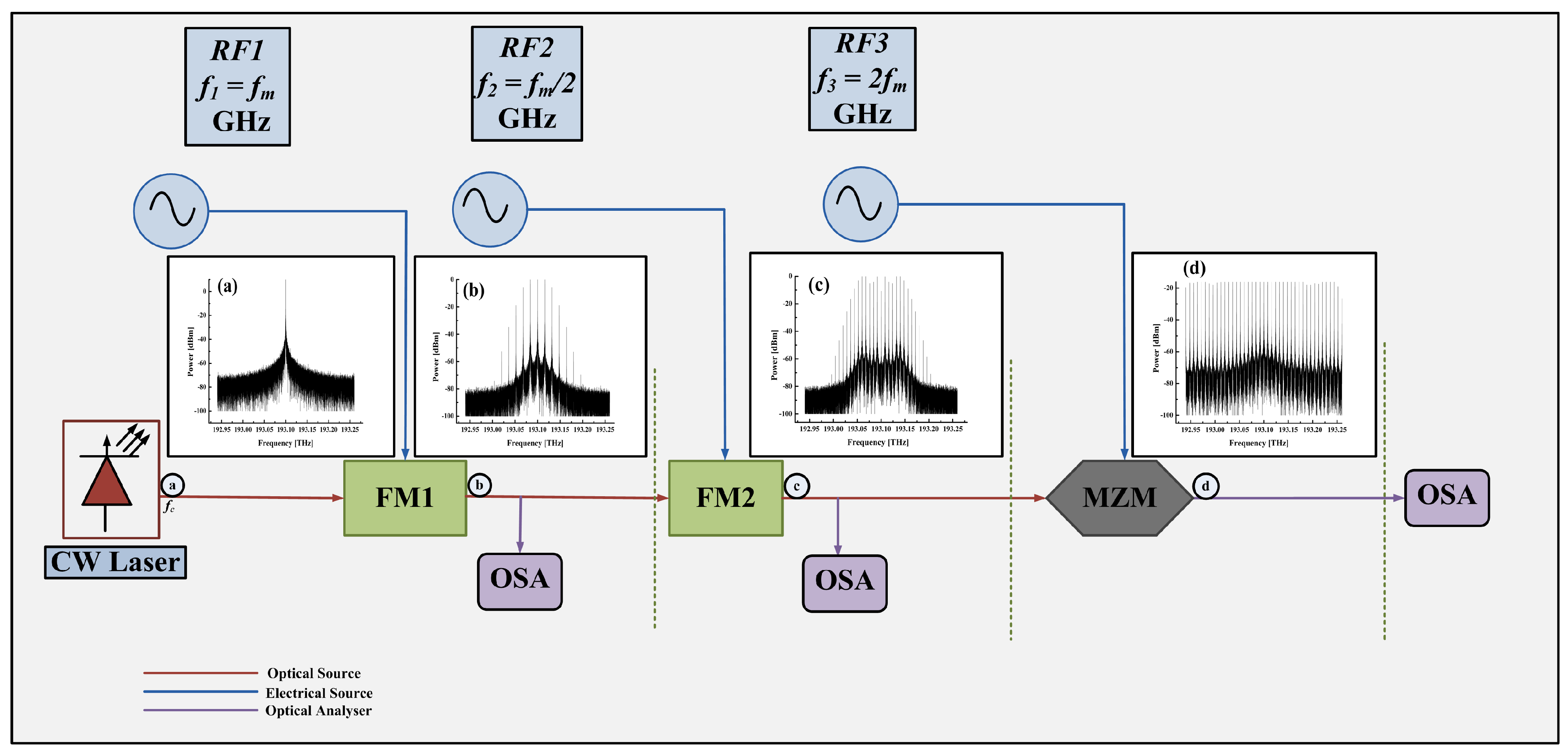
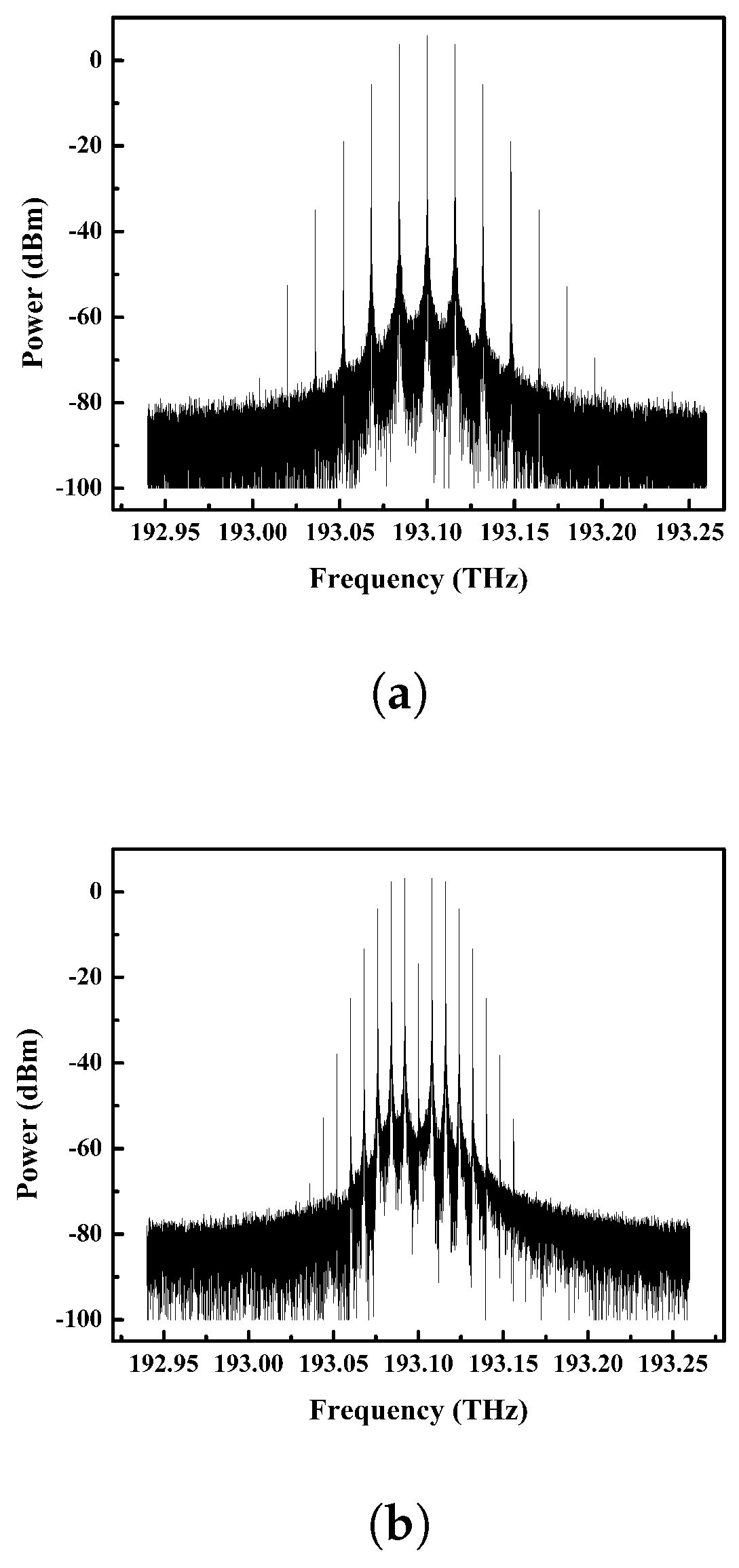
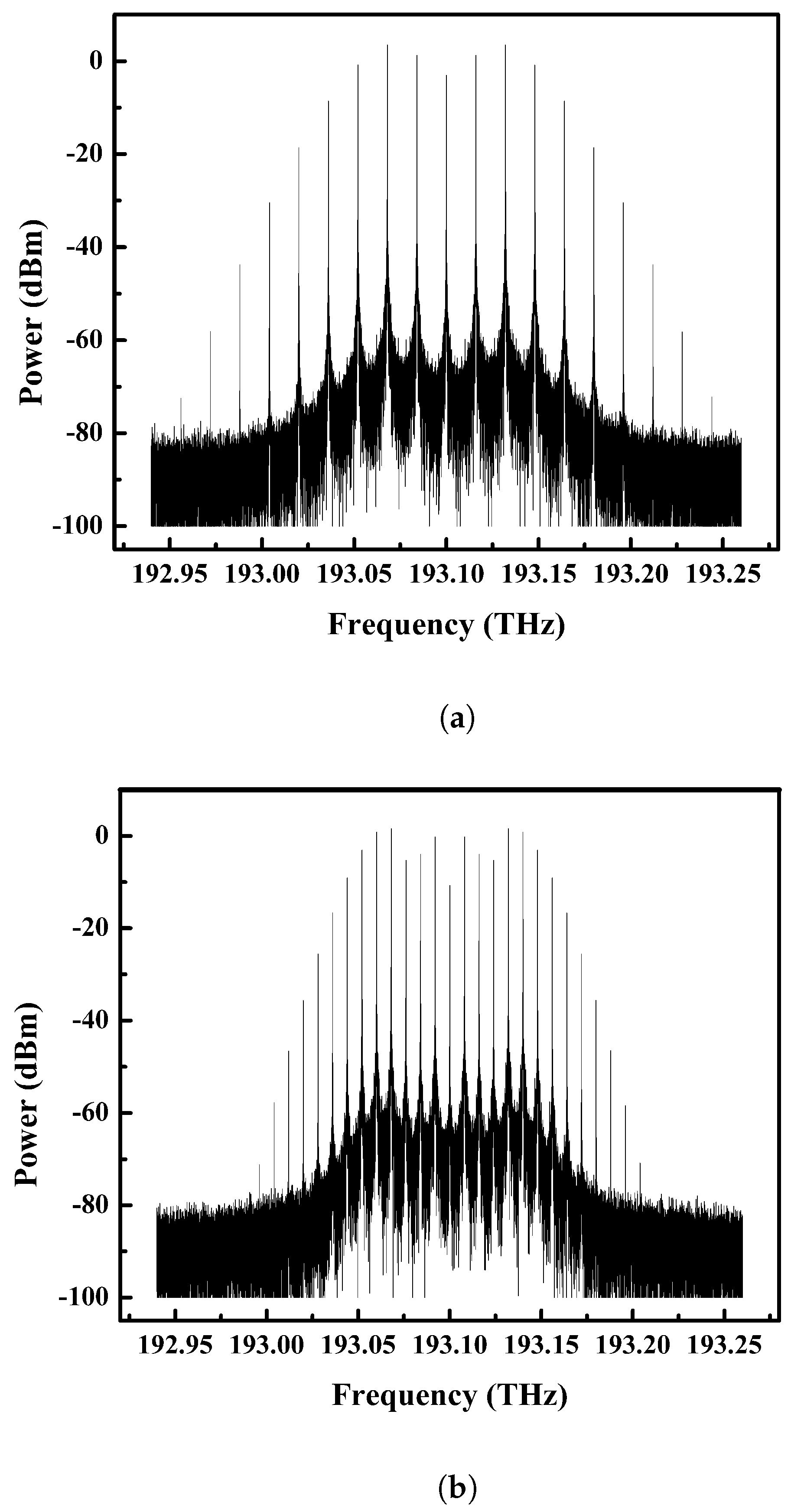


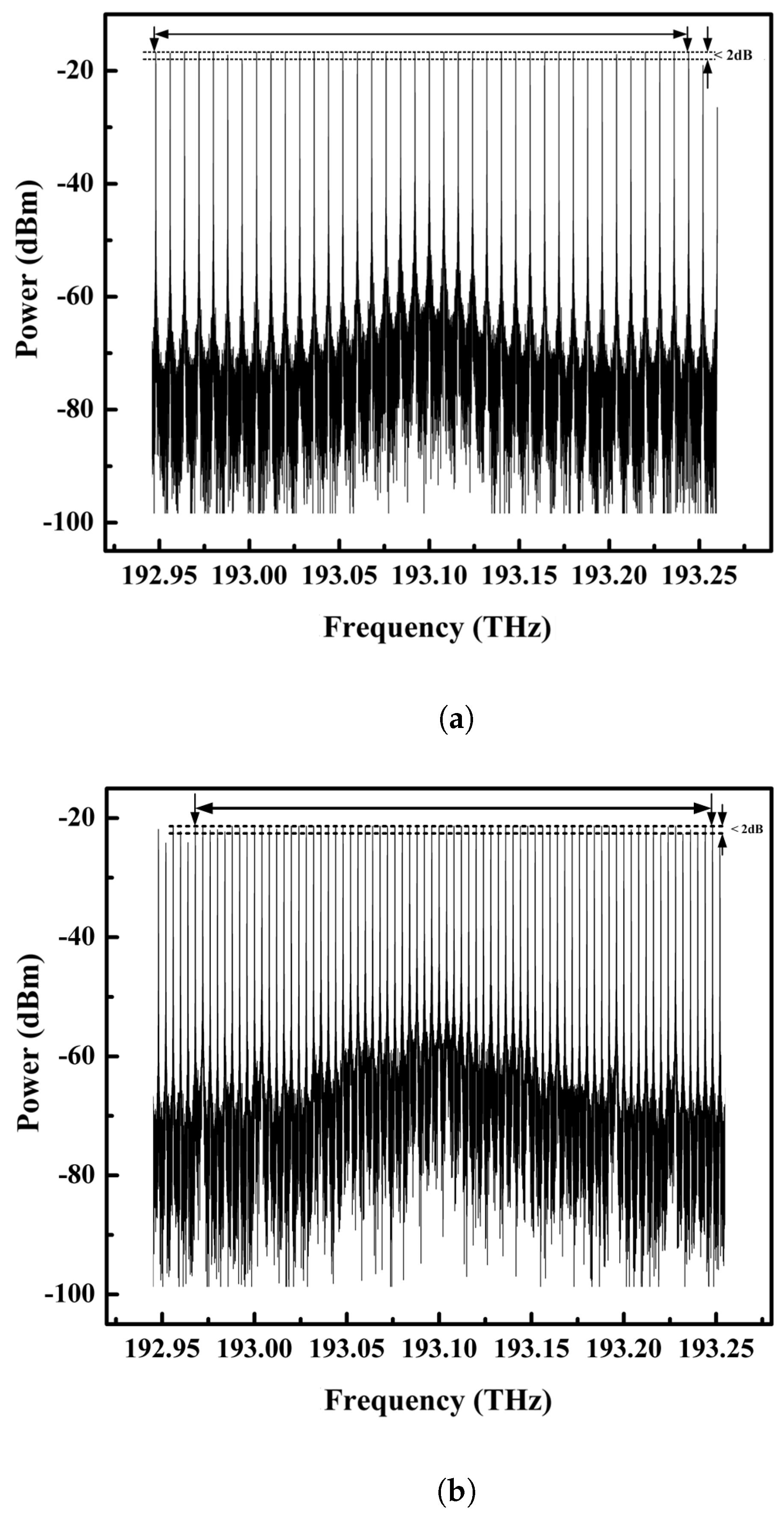
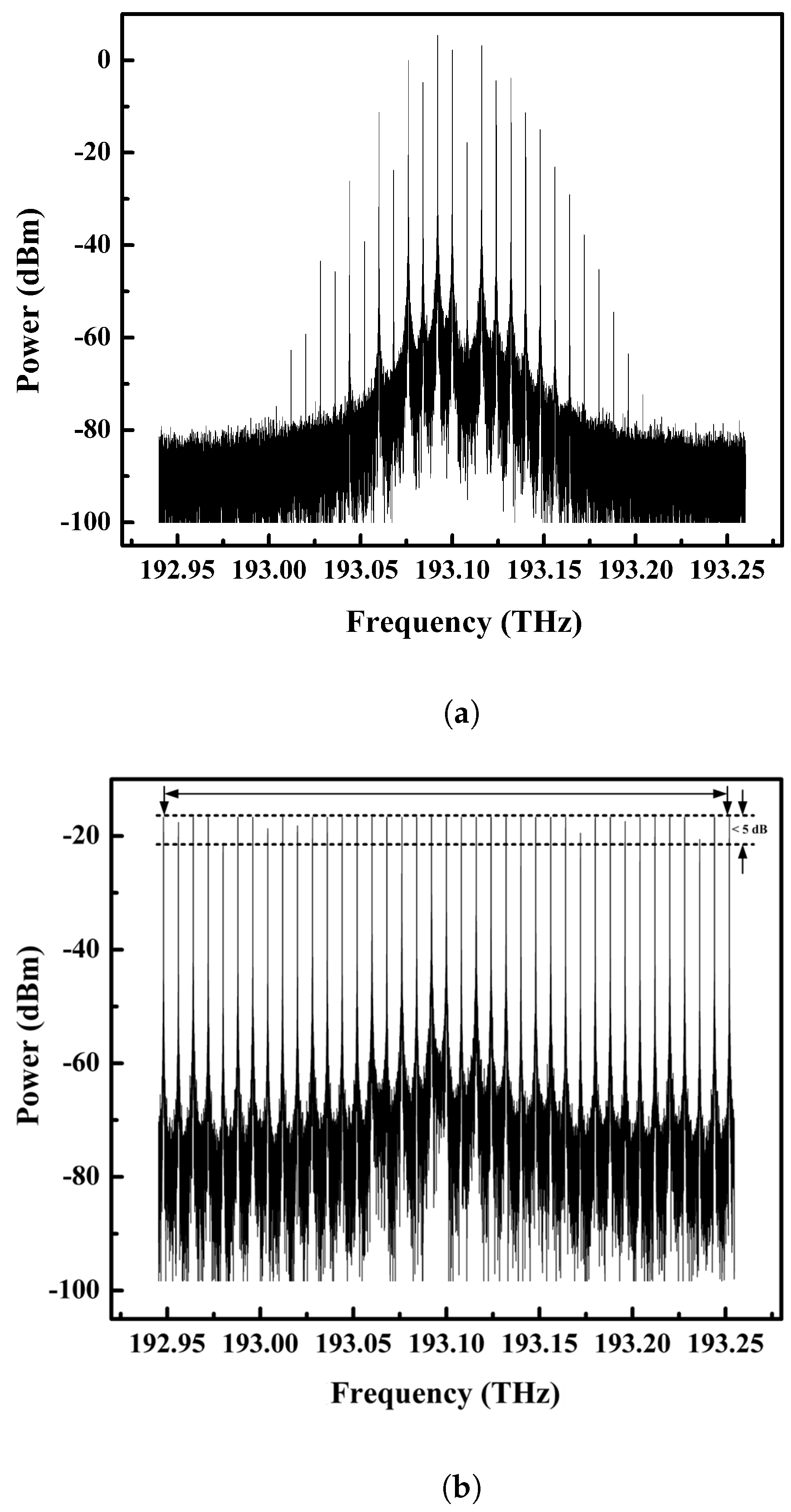
| Parameters | First Case | Second Case (Proposed) |
|---|---|---|
| RF signal frequencies (, , and ) | = GHz, = GHz, and = 2 GHz | = GHz, = /2 GHz, and = 2 GHz |
| Spectral components | Less | More |
| Number of comb lines ( = 16 GHz) | 19 | 37 |
| Number of comb lines ( = 8 GHz) | 38 | 71 |
| Subcarrier Spacing ( = 16 GHz and 8 GHz) | 16 GHz, 8 GHz | 8 GHz, 4 GHz |
| Power deviation | <1 dB | <2 dB |
Disclaimer/Publisher’s Note: The statements, opinions and data contained in all publications are solely those of the individual author(s) and contributor(s) and not of MDPI and/or the editor(s). MDPI and/or the editor(s) disclaim responsibility for any injury to people or property resulting from any ideas, methods, instructions or products referred to in the content. |
© 2023 by the authors. Licensee MDPI, Basel, Switzerland. This article is an open access article distributed under the terms and conditions of the Creative Commons Attribution (CC BY) license (https://creativecommons.org/licenses/by/4.0/).
Share and Cite
Ujjwal; Kumar, R. Optical Frequency Comb Generator Employing Two Cascaded Frequency Modulators and Mach–Zehnder Modulator. Electronics 2023, 12, 2762. https://doi.org/10.3390/electronics12132762
Ujjwal, Kumar R. Optical Frequency Comb Generator Employing Two Cascaded Frequency Modulators and Mach–Zehnder Modulator. Electronics. 2023; 12(13):2762. https://doi.org/10.3390/electronics12132762
Chicago/Turabian StyleUjjwal, and Rajkishor Kumar. 2023. "Optical Frequency Comb Generator Employing Two Cascaded Frequency Modulators and Mach–Zehnder Modulator" Electronics 12, no. 13: 2762. https://doi.org/10.3390/electronics12132762
APA StyleUjjwal, & Kumar, R. (2023). Optical Frequency Comb Generator Employing Two Cascaded Frequency Modulators and Mach–Zehnder Modulator. Electronics, 12(13), 2762. https://doi.org/10.3390/electronics12132762






